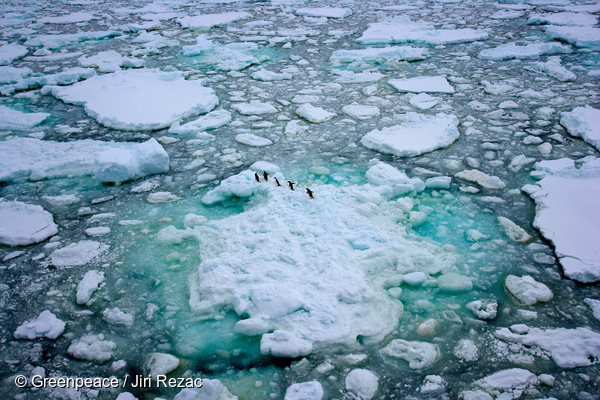Delay for Largest Protected Area on Earth
An attempt to establish a new marine-protected area in eastern Antarctic waters has failed at the 36th annual Meetings of the Commission for the Conservation of Antarctic Marine Living Resources (CCAMLR) which came to an end last week.
The proposal, submitted by the E.U. and championed by the German Government, will be considered again in October 2018. Meanwhile, environmental organization Greenpeace has launched a global campaign for the Antarctic Sanctuary, covering 1.8 million square kilometers of ocean, to protect whales, penguins and other wildlife. The Antarctic Sanctuary, the largest protected area on Earth, would be five times the size of Germany, in the Weddell Sea, next to the Antarctic peninsula.
The proposal follows the successful adoption of the Ross Sea sanctuary which was introduced by the U.S. and N.Z. governments and adopted last year. The Ross Sea sanctuary is currently the biggest marine protected area in the world, covering 1,550,000 square kilometers (roughly the size of three Texases, two Spains or one Mongolia), almost three quarters of which will be a fully-protected.

Three major MPA proposals were considered at CCAMLR this year: a revised proposal for an MPA in East Antarctica, a new proposal for an MPA in the Antarctic Peninsula region and an MPA in the Weddell Sea. Discussions for all three will continue over the next 12 months before they are again considered at next year’s annual meetings.
CCAMLR Chair, Dr Monde Mayekiso (South Africa), said that MPA decisions are very complex matters and consensus among Members takes significant time. “Although many of CCAMLR’s 25 Members considered that the East Antarctic proposal was ready for adoption, there are many complex scientific and geopolitical issues that are brought to bear in these negotiations. Consequently, we were not able to achieve consensus to adopt the proposal this year.”
Frida Bengtsson, head of Greenpeace’s Antarctic Campaign, says: “From great blue whales to vast colonies of Emperor and Adélie penguins, Antarctic wildlife is already under acute pressure from climate change and now industrial fishing vessels are vacuuming up the tiny shrimp-like krill which Antarctic life relies upon. The fishing industry simply can’t be allowed to expand their operations and steal food from threatened penguins and whales. We now have a unique opportunity to make sure that doesn't happen.
“We have just 12 months to create the largest protected area on Earth. With almost half our planet made up of waters outside of national borders, and an urgent global need for more large ocean sanctuaries, governments now need to show greater vision and ambition to protect what belongs to us all.”

Alex Rogers, Professor of Conservation Biology, University of Oxford said: “If we’re going to avoid the worst effects of climate change and protect biodiversity we need to safeguard more than 30 percent of our oceans, and the Antarctic is a fantastic place to start. Threats to the Antarctic are increasing, such as climate change and pollution, including from plastics and fishing. Creating large marine reserves can allow these ecosystems to remain in a fully diverse and functional state. Furthermore, the importance of Antarctic ecosystems in sequestering carbon is only now being realized. There is a narrow window of time for governments to work together to protect the oceans so the time for action is now.”

